Efficient Rock Mass Point Cloud Registration Based on Local Invariants
Abstract
1. Introduction
2. Related Work
2.1. Coarse Registration
2.2. Fine Registration
3. Methodology
3.1. Filtering Points of Interest
- (1)
- The tip of the rock: It is mainly located at the tip of the rock or a part of the rock.
- (2)
- The protruding part of the rock boundary: In general, the boundary of the rock is not a strictly straight line and, thus, the bulge of the boundary is considered to be the main feature on the rock boundary.
- (3)
- Bedding trace: The junction area of two or more rocks merges the features of multiple rocks.
- (4)
- Plane protrusion: In the rock mass, there may be protrusions in a plane area, and the characteristics of this area are obviously different from those of the surrounding plane.
3.2. Clustering
3.3. Pair Matching
3.4. Centroid Correction
4. Experimental Results and Analysis
- -
- The NDT method, proposed by Magnusson et al. [36], solves the transformation matrix based on statistical information after voxelizing the point cloud, which was provided with the PCL library.
- -
- The Generalized-ICP (G-ICP), proposed by Segal et al. [8], optimizes the distance criterion of the traditional ICP algorithm, which was provided with the PCL library.
- -
- -
4.1. Parameter Tuning
4.2. Datasets and Evaluation Metrics
4.3. Robustness Test
4.4. Analysis of Registration Results for Rock Mass
4.5. Runtime Analysis
5. Discussion
- (1)
- Efficient and accurate selection of points of interest. Starting from the prior knowledge that feature points are usually located in regions with drastic changes (e.g., the four types of feature regions introduced in Section 3.1), by using the relationship between the center point and the neighboring points to form a vector, the points in the feature region are effectively selected out. After this process, only a small number of points of interest is retained, which greatly reduces the amount of further calculations.
- (2)
- Efficient matching method. Point of interest matching is essential for finding the similarity between points of interest. We found that the geometry formed by the point and its neighbors after rotation has an invariant quantity, which allows a local point set to be considered as a whole, rather than just considering the individual point. In addition, the comparison of invariants on multiple scales improves the robustness of the method.
- (3)
- Fine adjustment of point position. After finding the corresponding point, fine-tuning of the point can align the position of the feature point. This step further improves the accuracy of the proposed method.
6. Conclusions
Author Contributions
Funding
Institutional Review Board Statement
Informed Consent Statement
Data Availability Statement
Acknowledgments
Conflicts of Interest
References
- Sturzenegger, M.; Stead, D. Close-range terrestrial digital photogrammetry and terrestrial laser scanning for discontinuity characterization on rock cuts. Eng. Geol. 2009, 106, 163–182. [Google Scholar] [CrossRef]
- Hu, L.; Xiao, J.; Wang, Y. An automatic 3D Registration method for rock mass point clouds based on plane detection and polygon matching. Vis. Comput. 2019, 36, 669–681. [Google Scholar] [CrossRef]
- Besl, P.J.; McKay, N.D. Method for Registration of 3-D Shapes. In Sensor Fusion IV: Control Paradigms and Data Structures; Schenker, P.S., Ed.; SPIE: Bellingham, WA, USA, 1992; Volume 1611, pp. 586–606. [Google Scholar] [CrossRef]
- Granger, S.; Pennec, X. Multi-scale EM-ICP: A fast and robust approach for surface registration. In Proceedings of the European Conference on Computer Vision, Copenhagen, Denmark, 28–31 May 2002; pp. 418–432. [Google Scholar]
- Pulli, K. Multiview registration for large data sets. In Proceedings of the Second International Conference on 3-D Digital Imaging and Modeling (Cat. No.PR00062), Ottawa, ON, Canada, 8 October 1999. [Google Scholar] [CrossRef]
- Bouaziz, S.; Tagliasacchi, A.; Pauly, M. Sparse Iterative Closest Point. In Proceedings of the Eleventh Eurographics/ACMSIGGRAPH Symposium on Geometry Processing, Genova, Italy, 3–5 July 2013; pp. 113–123. [Google Scholar]
- Mohammadzade, H.; Hatzinakos, D. Iterative closest normal point for 3D face recognition. IEEE Trans. Pattern Anal. Mach. Intell. 2013, 35, 381–397. [Google Scholar] [CrossRef] [PubMed]
- Segal, A.; Hähnel, D.; Thrun, S. Generalized-ICP. In Proceedings of the Robotics: Science and Systems V, Seattle, WA, USA, 28 June 28–1 July 2009; The MIT Press: Cambridge, MA, USA, 2009. [Google Scholar] [CrossRef]
- Chen, C.S.; Yi-Ping, H.; Cheng, J.B. A fast automatic method for registration of partially-overlapping range images. In Proceedings of the Sixth International Conference on Computer Vision (IEEE Cat. No.98CH36271), Bombay, India, 7 January 1998; pp. 242–248. [Google Scholar]
- Aiger, D.; Mitra, N.J.; Cohen-Or, D. 4-Points congruent sets for robust pairwise surface registration. ACM Trans. Graph. 2008, 27. [Google Scholar] [CrossRef]
- Mellado, N.; Aiger, D.; Mitra, N.J. Super 4PCS Fast Global Pointcloud Registration via Smart Indexing. Comput. Graph. Forum 2014, 33, 205–215. [Google Scholar] [CrossRef]
- Theiler, P.W.; Wegner, J.D.; Schindler, K. Keypoint-based 4-Points Congruent Sets–Automated marker-less registration of laser scans. ISPRS J. Photogramm. Remote Sens. 2014, 96, 149–163. [Google Scholar] [CrossRef]
- Mohamad, M.; Rappaport, D.; Greenspan, M. Generalized 4-Points Congruent Sets for 3D Registration. In Proceedings of the 2nd International Conference on 3D Vision, Tokyo, Japan, 8–11 December 2014; Volume 1, pp. 83–90. [Google Scholar] [CrossRef]
- Mohamad, M.; Ahmed, M.T.; Rappaport, D.; Greenspan, M. Super Generalized 4PCS for 3D Registration. In Proceedings of the 2015 International Conference on 3D Vision, Lyon, France, 19–22 October 2015; pp. 598–606. [Google Scholar] [CrossRef]
- Wang, F.; Xiao, J.; Wang, Y. Efficient Rock-mass Point Cloud Registration Using N-point Complete Graphs. IEEE Trans. Geosci. Remote Sens. 2019, 57, 9332–9343. [Google Scholar] [CrossRef]
- Rusu, R.B.; Marton, Z.C.; Blodow, N.; Beetz, M. Persistent point feature histograms for 3D point clouds. In Proceedings of the 10th International Conference on Intelligent Autonomous Syst (IAS-10), Baden-Baden, Germany, January 2008; pp. 119–128. [Google Scholar]
- Rusu, R.B.; Blodow, N.; Beetz, M. Fast Point Feature Histograms (FPFH) for 3D registration. In Proceedings of the 2009 IEEE International Conference on Robotics and Automation, Kobe, Japan, 12–17 May 2009; pp. 3212–3217. [Google Scholar] [CrossRef]
- Tombari, F.; Salti, S.; Di Stefano, L. Unique signatures of histograms for local surface description. In Proceedings of the European Conference on Computer Vision, Crete, Greece, 5–11 September 2010; pp. 356–369. [Google Scholar]
- Habib, A.; Ghanma, M.; Morgan, M.; Al-Ruzouq, R. Photogrammetric and LiDAR data registration using linear features. Photogramm. Eng. Remote Sens. 2005, 71, 699–707. [Google Scholar] [CrossRef]
- Al-Durgham, M.; Habib, A. A framework for the registration and segmentation of heterogeneous LiDAR data. Photogramm. Eng. Remote Sens. 2013, 79, 135–145. [Google Scholar] [CrossRef]
- Yang, B.; Zang, Y. Automated registration of dense terrestrial laser-scanning point clouds using curves. ISPRS J. Photogramm. Remote Sens. 2014, 95, 109–121. [Google Scholar] [CrossRef]
- Dold, C.; Brenner, C. Registration of terrestrial laser scanning data using planar patches and image data. Int. Arch. Photogramm. Remote Sens. Spat. Inf. Sci. ISPRS Arch. 2006, 36, 78–83. [Google Scholar]
- Huang, J.; Kwok, T.H.; Zhou, C. V4PCS: Volumetric 4PCS algorithm for global registration. J. Mech. Des. 2017, 139. [Google Scholar] [CrossRef]
- Zeng, A.; Song, S.; Nießner, M.; Fisher, M.; Xiao, J.; Funkhouser, T. 3dmatch: Learning local geometric descriptors from rgb-d reconstructions. In Proceedings of the IEEE Conference on Computer Vision and Pattern Recognition, Honolulu, HI, USA, 21–26 July 2017; pp. 1802–1811. [Google Scholar]
- Gojcic, Z.; Zhou, C.; Wegner, J.D.; Wieser, A. The perfect match: 3d point cloud matching with smoothed densities. In Proceedings of the IEEE Conference on Computer Vision and Pattern Recognition, Long Beach, CA, USA, 16–20 June 2019; pp. 5545–5554. [Google Scholar]
- Wang, Y.; Solomon, J.M. Deep closest point: Learning representations for point cloud registration. In Proceedings of the IEEE International Conference on Computer Vision, Seoul, Korea, 27 October–2 November 2019; pp. 3523–3532. [Google Scholar]
- Aoki, Y.; Goforth, H.; Srivatsan, R.A.; Lucey, S. Pointnetlk: Robust & efficient point cloud registration using pointnet. In Proceedings of the IEEE Conference on Computer Vision and Pattern Recognition, Long Beach, CA, USA, 16–20 June 2019; pp. 7163–7172. [Google Scholar]
- Qi, C.R.; Su, H.; Mo, K.; Guibas, L.J. Pointnet: Deep learning on point sets for 3d classification and segmentation. In Proceedings of the IEEE Conference on Computer Vision and Pattern Recognition, Honolulu, HI, USA, 21–26 July 2017; pp. 652–660. [Google Scholar]
- Lucas, B.D.; Kanade, T. An Iterative Image Registration Technique with an Application to Stereo Vision. In Proceedings of the 7th International Joint Conference on Artificial Intelligence, Vancouver, BC, Canada, 24–28 August 1981; pp. 674–679. [Google Scholar]
- Fitzgibbon, A.W. Robust registration of 2D and 3D point sets. Image Vis. Comput. 2003, 21, 1145–1153. [Google Scholar] [CrossRef]
- Chetverikov, D.; Svirko, D.; Stepanov, D.; Krsek, P. The trimmed iterative closest point algorithm. In Proceedings of the Object Recognition Supported by User Interaction for Service Robots, Quebec City, QC, Canada, 11–15 August 2002; Volume 3, pp. 545–548. [Google Scholar]
- Mavridis, P.; Andreadis, A.; Papaioannou, G. Efficient sparse icp. Comput. Aided Geom. Des. 2015, 35, 16–26. [Google Scholar] [CrossRef]
- Grant, D.; Bethel, J.; Crawford, M. Point-to-plane registration of terrestrial laser scans. ISPRS J. Photogramm. Remote Sens. 2012, 72, 16–26. [Google Scholar] [CrossRef]
- Censi, A. An ICP variant using a point-to-line metric. In Proceedings of the 2008 IEEE International Conference on Robotics and Automation, Pasadena, CA, USA, 19–23 May 2008; pp. 19–25. [Google Scholar]
- Rusinkiewicz, S. A symmetric objective function for ICP. ACM Trans. Graph. (TOG) 2019, 38, 1–7. [Google Scholar] [CrossRef]
- Magnusson, M.; Lilienthal, A.; Duckett, T. Scan registration for autonomous mining vehicles using 3D-NDT. J. Field Robot. 2007, 24, 803–827. [Google Scholar] [CrossRef]
- Gruen, A.; Akca, D. Least squares 3D surface and curve matching. ISPRS J. Photogramm. Remote Sens. 2005, 59, 151–174. [Google Scholar] [CrossRef]
- Jian, B.; Vemuri, B.C. A robust algorithm for point set registration using mixture of Gaussians. In Proceedings of the Tenth IEEE International Conference on Computer Vision (ICCV’05), Beijing, China, 17–21 October 2005; Volume 2, pp. 1246–1251. [Google Scholar]
- Pomerleau, F.; Colas, F.; Siegwart, R.; Magnenat, S. Comparing ICP variants on real-world data sets. Auton. Robot. 2013, 34, 133–148. [Google Scholar] [CrossRef]
- Ester, M.; Kriegel, H.; Sander, J.; Xu, X. A Density-Based Algorithm for Discovering Clusters in Large Spatial Databases with Noise. In Proceedings of the Second International Conference on Knowledge Discovery and Data Mining (KDD-96), Portland, OR, USA, 2–4 August 1996; pp. 226–231. [Google Scholar]
- Rusu, R.B.; Cousins, S. 3D is here: Point Cloud Library (PCL). In Proceedings of the 2011 IEEE International Conference on Robotics and Automation, Shanghai, China, 9–13 May 2011; pp. 1–4. [Google Scholar] [CrossRef]
- Lato, M.; Kemeny, J.; Harrap, R.; Bevan, G. Rock bench: Establishing a common repository and standards for assessing rockmass characteristics using LiDAR and photogrammetry. Comput. Geosci. 2013, 50, 106–114. [Google Scholar] [CrossRef]
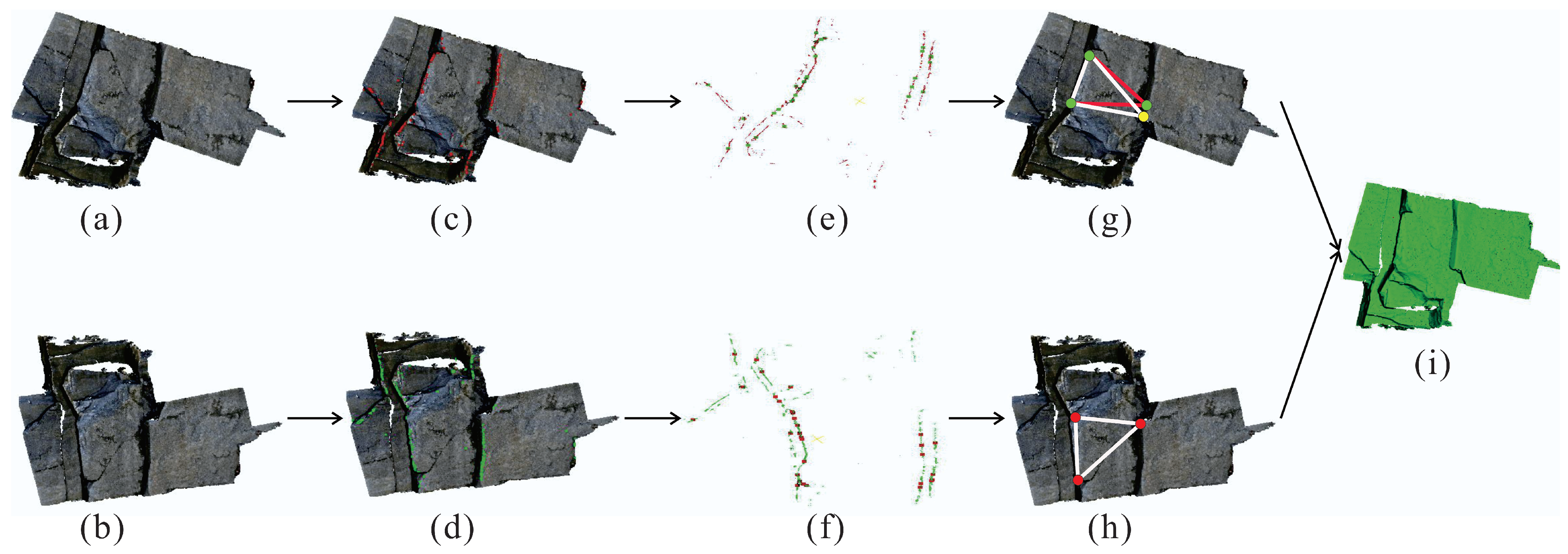

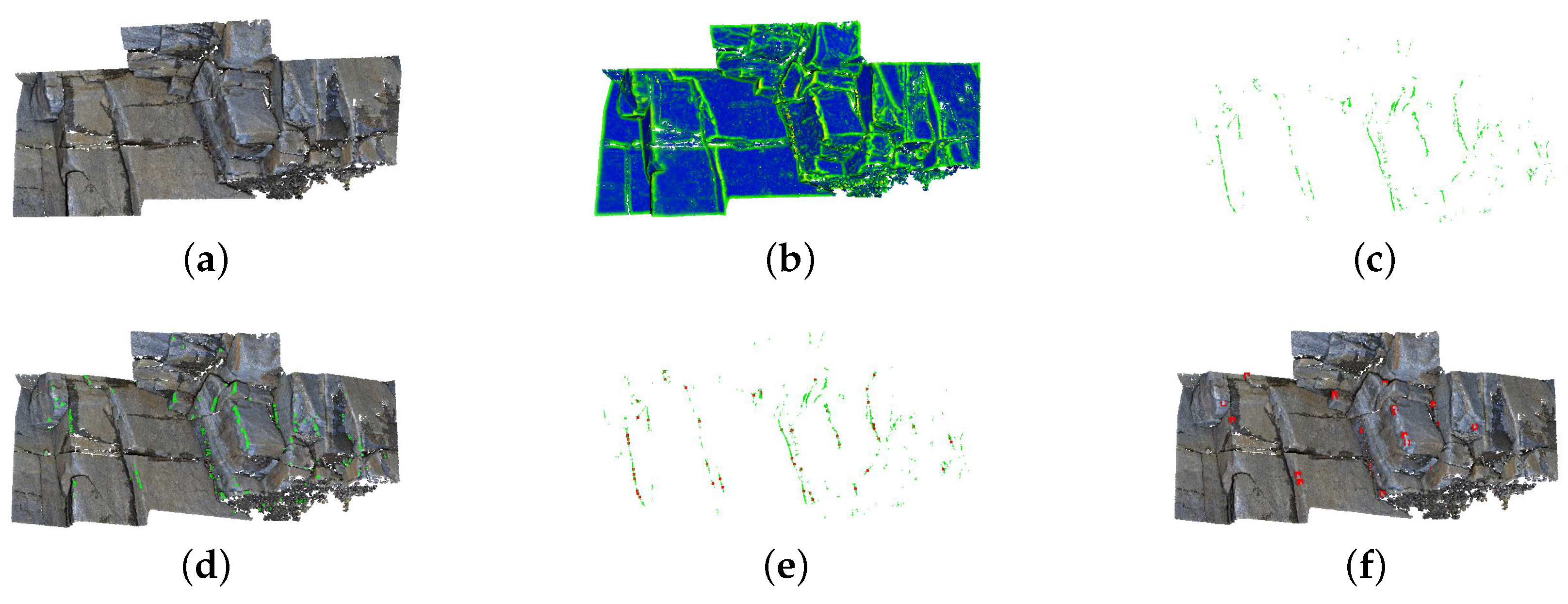
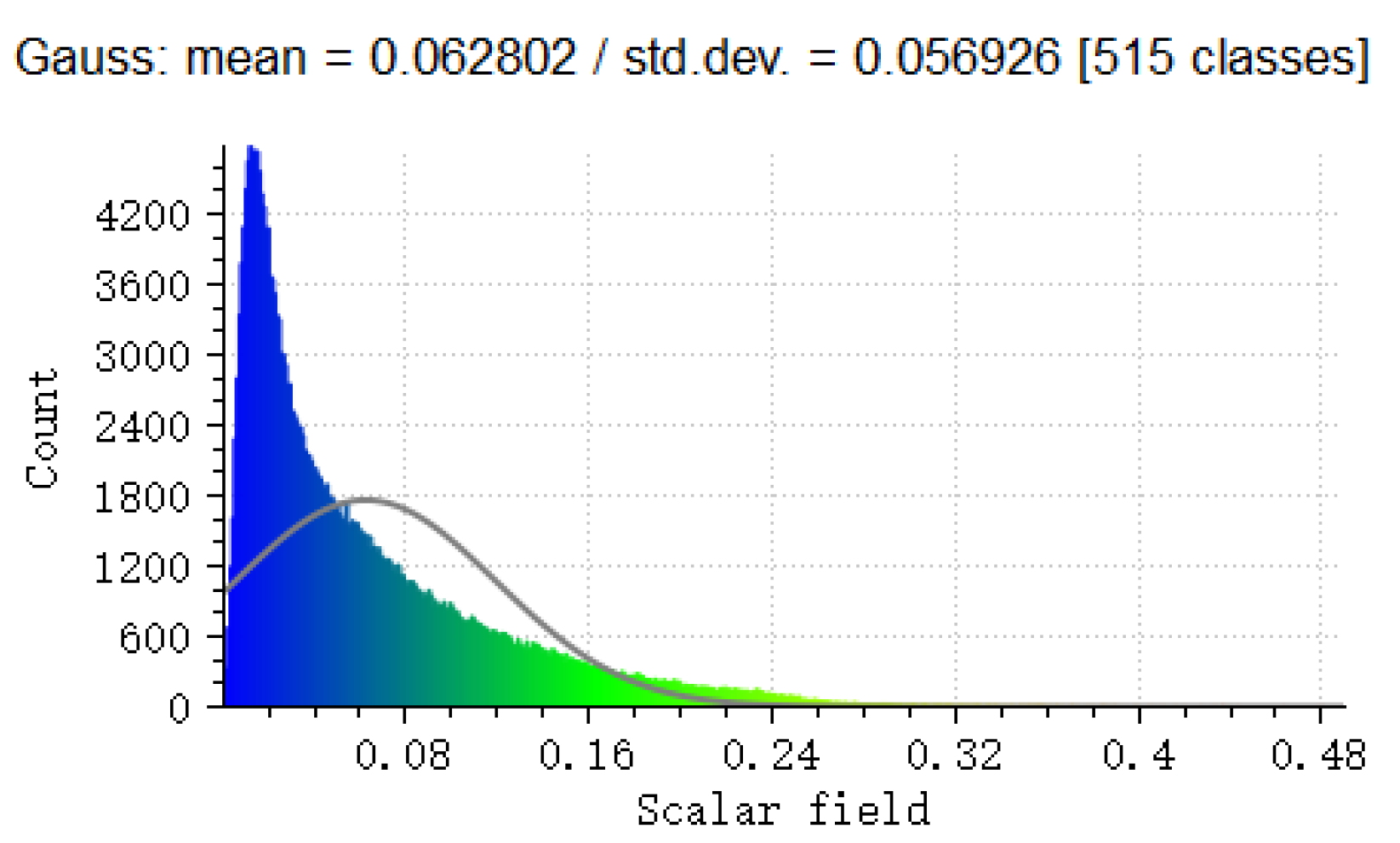
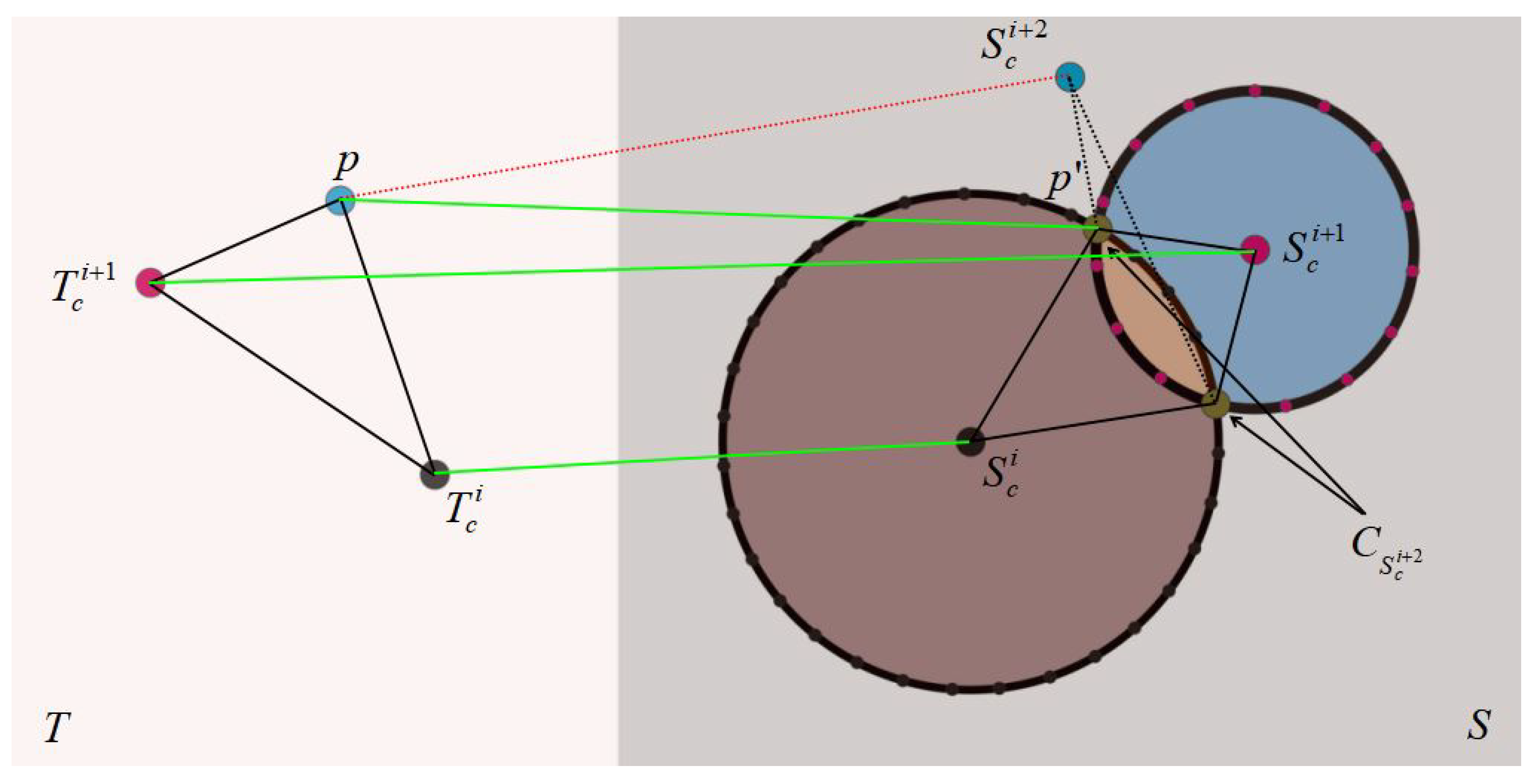
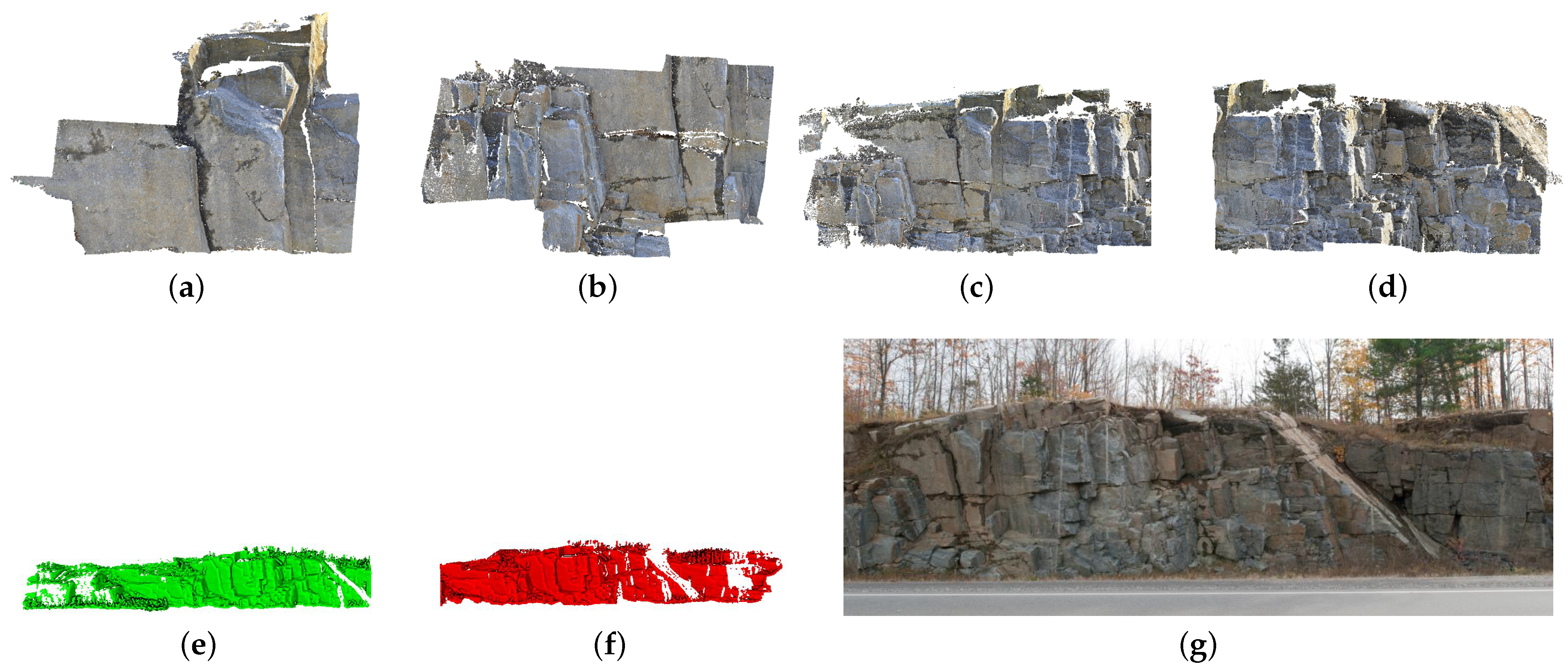


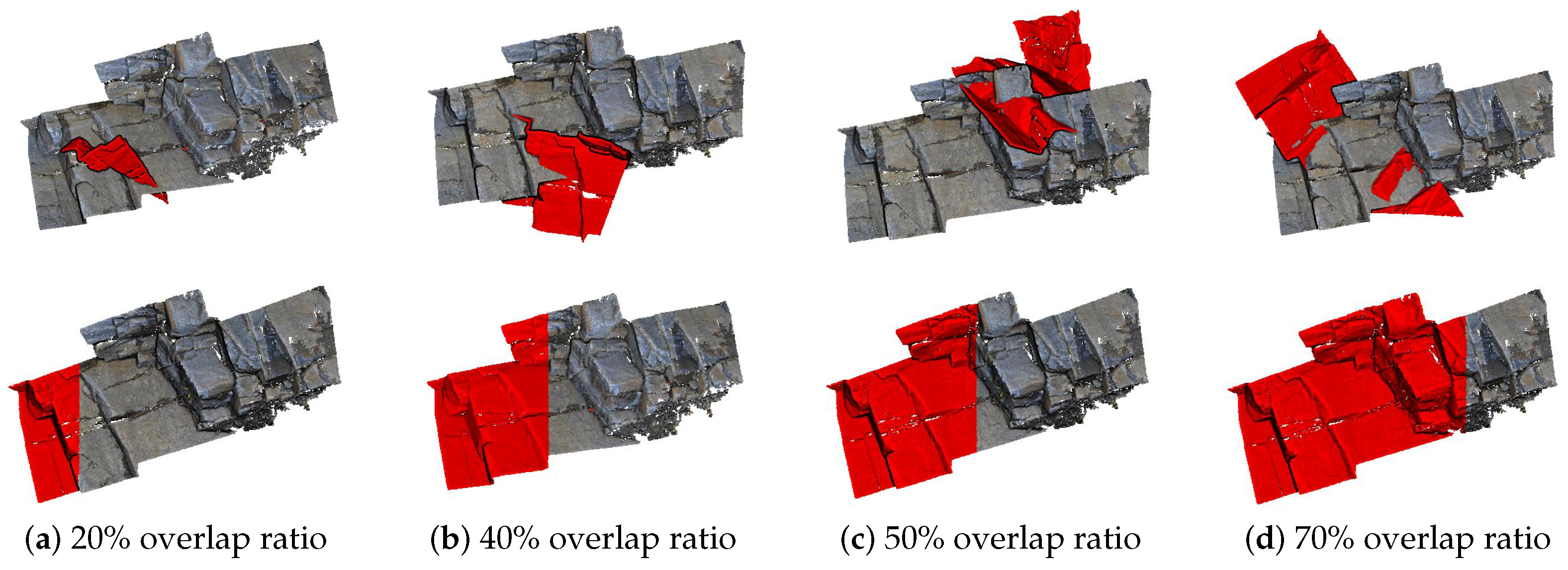
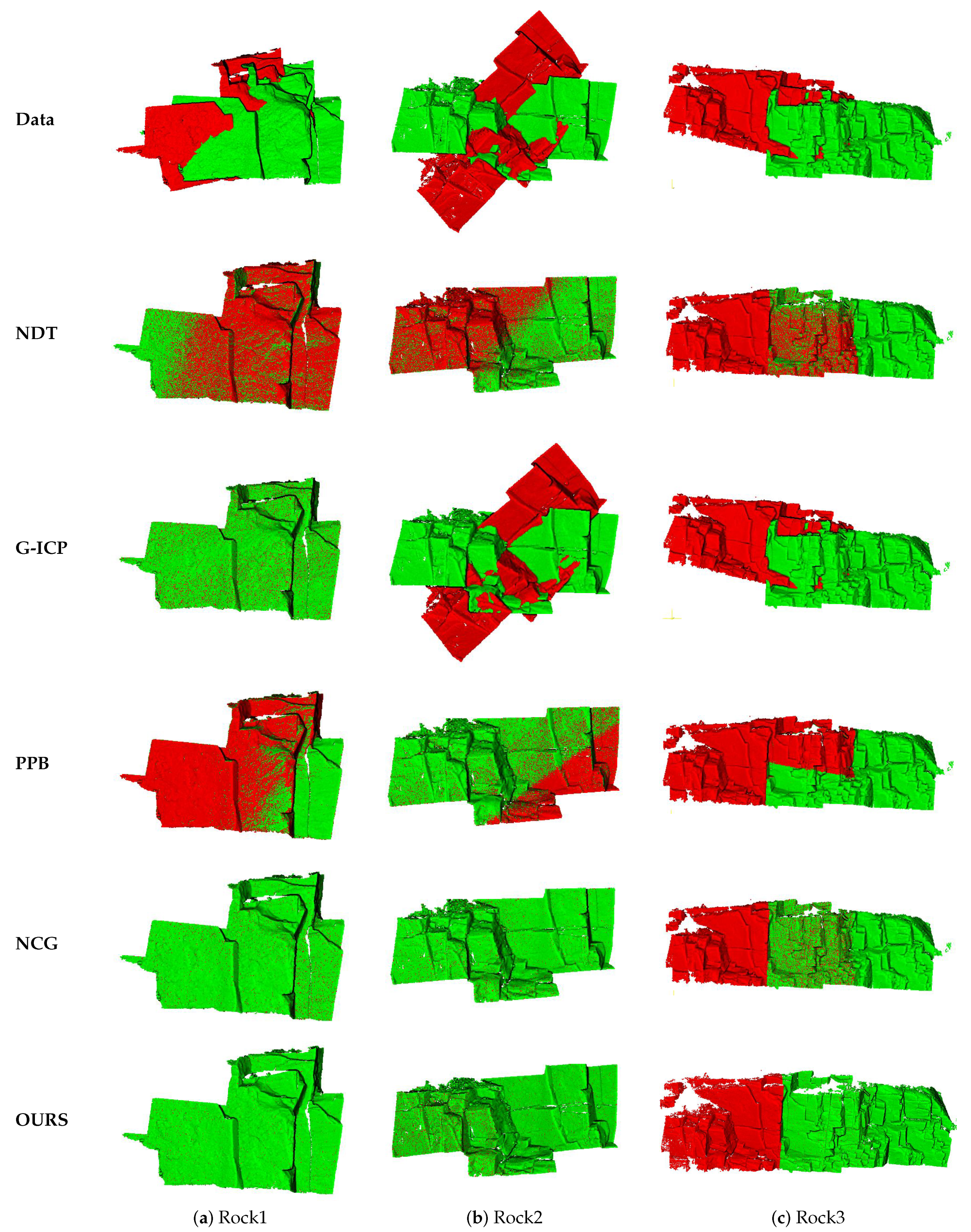
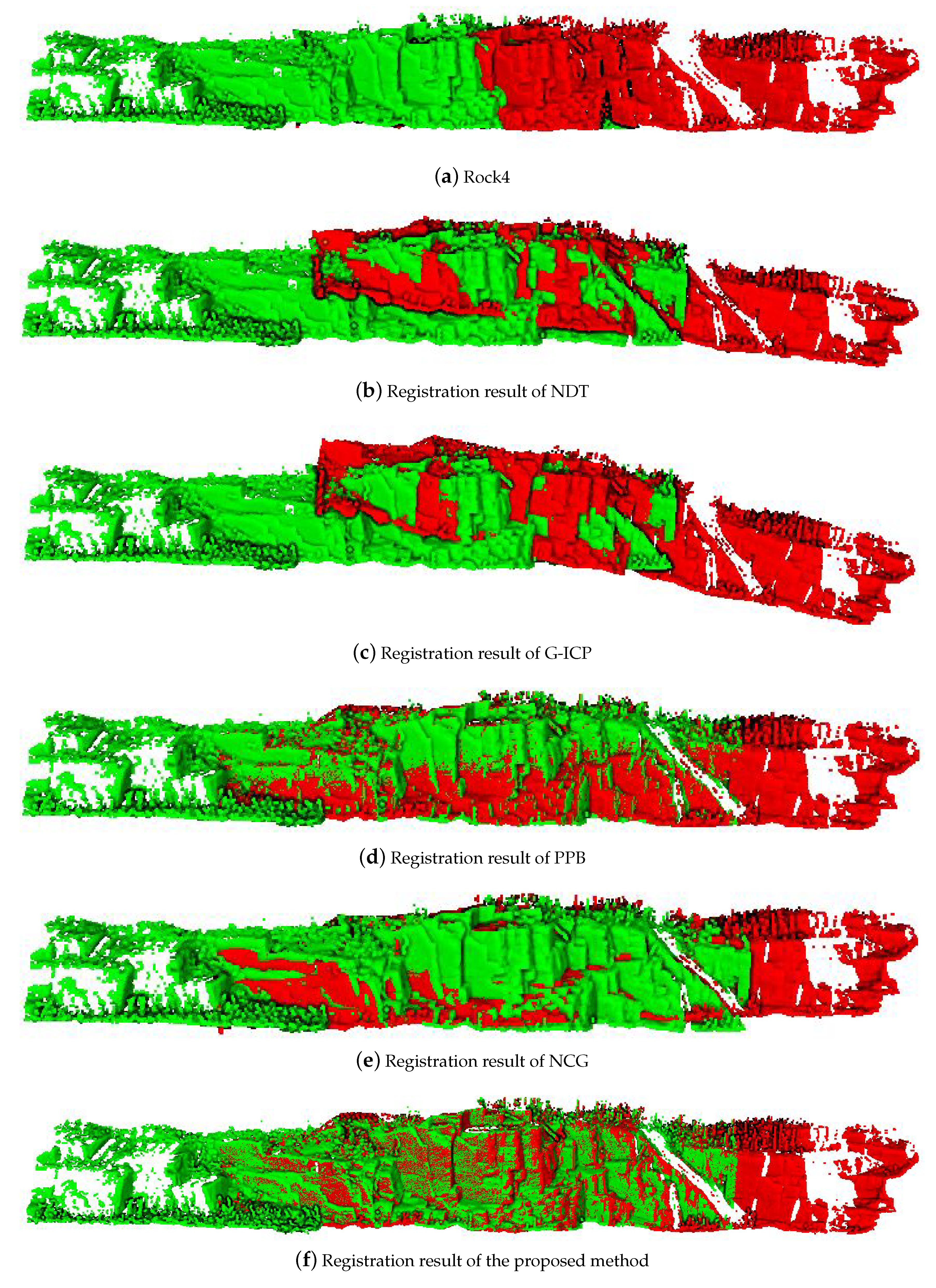
| Stage | ID | Parameters | Meaning | Configuration Method |
|---|---|---|---|---|
| Filtering Points of Interest | 1 | r | Search radius | 0.2–0.5 m |
| 2 | The minimum allowable value of SVF | 0.1–1, depending on the number of points and the search radius | ||
| 3 | The maximum allowable value of SVF | 0.2–2, depending on the number of points and the search radius | ||
| 4 | k | Number of sampling points | 32–128, depending on the point cloud density | |
| 5 | The minimum allowable size of | 2*k–5*k, depending on k and the point cloud density | ||
| Clustering | 1 | The clustering radius | 0.05–0.2 m, related to the density of the point cloud | |
| 2 | Minimum number of points of valid cluster | 16–128, related to the density of the point cloud | ||
| 3 | Maximum size of valid cluster | Default is 10 m | ||
| Pair Matching | 1 | Maximum difference between corresponding points | Default is 1.0 | |
| 2 | Number of sampling points for calculating the centroid in pair matching stage | Default is 16 | ||
| Centroid Correction | 1 | ℓ | Permissible error range for position correction | Default is 0.1 m |
| 2 | Number of sampling points for calculating the centroid in centroids correction stage | Default is 16 |
| Data | Number of Points | Bounding Box Size (m) | Density (r = 0.5 m) |
|---|---|---|---|
| Rock1 | 306,778 | 413.06 | |
| Rock2 | 264,309 | 164.33 | |
| Rock3-Part1 | 1,638,869 | 635.49 | |
| Rock3-Part2 | 1,517,037 | 628.69 | |
| Rock4-Part1 | 467,310 | 1426.86 | |
| Rock4-Part2 | 486,966 | 1413.57 |
| Method | Rock1 | Rock2 | Rock3 | Rock4 |
|---|---|---|---|---|
| NDT | 2.79e-02 | 1.69e-02 | 1.61e-02 | 5.66e-02 |
| G-ICP | 1.53e-05 | 1.22e+01 | 2.95e-00 | 5.90e-02 |
| PPB | 5.12e-02 | 2.99e-02 | 7.31e-00 | 3.50e-02 |
| NCG | 2.84e-06 | 5.17e-06 | 2.68e-05 | 7.75e-03 |
| OURS | 3.22e-07 | 5.31e-07 | 2.37e-06 | 6.82e-03 |
| Method | Rock1 | Rock2 | Rock3 | Rock4 |
|---|---|---|---|---|
| NDT | 100.408 | 173.942 | 4375.56 | 526.72 |
| G-ICP | 88.654 | 433.265 | 3994.34 | 614.06 |
| PPB | 13.201 | 10.920 | 143.597 | 39.846 |
| NCG | 50.882 | 38.775 | 463.716 | 59.86 |
| OURS | 14.891 | 12.292 | 72.363 | 31.014 |
Publisher’s Note: MDPI stays neutral with regard to jurisdictional claims in published maps and institutional affiliations. |
© 2021 by the authors. Licensee MDPI, Basel, Switzerland. This article is an open access article distributed under the terms and conditions of the Creative Commons Attribution (CC BY) license (https://creativecommons.org/licenses/by/4.0/).
Share and Cite
Wang, Y.; Xiao, J.; Liu, L.; Wang, Y. Efficient Rock Mass Point Cloud Registration Based on Local Invariants. Remote Sens. 2021, 13, 1540. https://doi.org/10.3390/rs13081540
Wang Y, Xiao J, Liu L, Wang Y. Efficient Rock Mass Point Cloud Registration Based on Local Invariants. Remote Sensing. 2021; 13(8):1540. https://doi.org/10.3390/rs13081540
Chicago/Turabian StyleWang, Yunbiao, Jun Xiao, Lupeng Liu, and Ying Wang. 2021. "Efficient Rock Mass Point Cloud Registration Based on Local Invariants" Remote Sensing 13, no. 8: 1540. https://doi.org/10.3390/rs13081540
APA StyleWang, Y., Xiao, J., Liu, L., & Wang, Y. (2021). Efficient Rock Mass Point Cloud Registration Based on Local Invariants. Remote Sensing, 13(8), 1540. https://doi.org/10.3390/rs13081540







